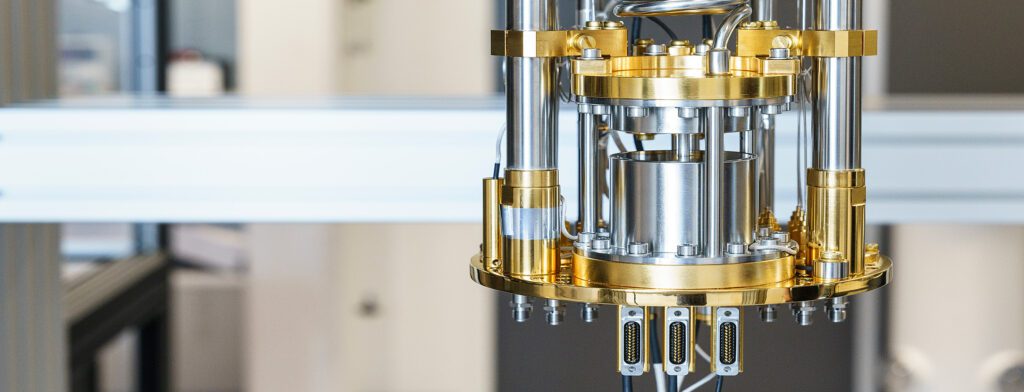QuTech is proud to be the coordinator of a collaborative research project that focuses on high-fidelity operation in spin-qubit registers, funded by the US Army Research Office (ARO) and the Dutch Ministry of Defense. Menno Veldhorst is the Principal Investigator responsible for the overall project.
Its overarching objective is to demonstrate multi-qubit systems of 5-10 qubits with high-fidelity readout, initialization, and control and create coherent coupling between remote spin qubit registers, in order to obtain a compelling path for scaling up to large numbers of quantum dot qubits.
Spin qubits in germanium and silicon
Advances and new insights in the growth of silicon-germanium heterostructures have widened the opportunities to develop excellent hosts for spin qubits.
The consortium is exploring novel qubit approaches based on holes in germanium and electrons in wiggle-well silicon-germanium structures and aiming to advance state-of-the-art silicon spin qubits. These different routes will be compared having in mind scaling up to large numbers of spin qubits with high-fidelity control.
The consortium aims to accomplish high fidelity (>99%) operation of spin qubit registers that can be coupled coherently and will consolidate its findings to put forward a blueprint for larger qubit systems containing around 100 qubits and more.
Key obstacles
Fast and high-fidelity single qubit gates, two-qubit gates, readout and initialization have all been demonstrated in separate experiments and devices. However, even better performance is still needed, and this needs to be integrated into a single system. Therefore, further advances of the entire system are required.
Basic science challenges remain in obtaining large excited-state energies, improving the tunability of quantum dots, and building scalable and efficient quantum control and readout. Furthermore, while the small size of quantum dots is an advantage for long term scalability, it also poses challenges in interconnecting and operating two-dimensional quantum dot arrays. Lastly, operating larger systems comes with new challenges, many of which are not well understood.
Possible solutions
The consortium is focusing on materials development, qubit encoding, qubit control and benchmarking, and on analysis using systematic and rigorous methods.
In terms of materials development the consortium is convinced that buried heterostructures are essential and is focusing on Ge/SiGe and Si/SiGe heterostructures. In terms of qubit encoding, single-spin qubits are used as the starting point as these currently define the state of the art and offer many advantages. Since other qubit encodings such as singlet-triplet qubits and multi-spin encodings may prove to more beneficial, these will also be investigated and benchmarked in the consortium. In the area of qubit control and benchmarking, in addition to human-controlled experiments, the team is working towards obtaining autonomous control, which is envisioned a crucial aspect in scaling quantum devices to larger systems.
Collaboration on a global scale
With members from four universities and one national lab across three continents, this project is a great example of international science-based research on a global scale. The objectives are highly ambitious and demand a strong consortium with core expertise and excellent infrastructure and that can efficiently collaborate. The team that has been assembled, has made foundational contributions to the field of silicon and germanium quantum technology, and has unique expertise in materials, fabrication, measurement, and theory. It also has already had numerous pairwise and three-way interactions with deep connections on scientific projects.

Delft University of Technology / QuTech
Kavli Institute of Nanoscience
University of Wisconsin-Madison
University of New South Wales
Harvard University
Sandia National Laboratories
The distribution of the research disciplines across the partners is as follows:
1. Materials and fabrication – QuTech, University of Wisconsin-Madison, Sandia National Laboratories
- Material growth: QuTech Giordano Scappucci lab, Delft
- Fabrication: Delft, Sandia, Wisconsin
- Experiments: Delft, Wisconsin, Harvard
- Theory: Delft (Viatcheslav Dobrovitski, Maximilian Rimbach-Russ, Stefano Bosco), Wisconsin (Mark Friesen, Rob Joynt), UNSW (Susan Coppersmith)
2. Qubit type and performance – QuTech, University of Wisconsin-Madison, Harvard University
- Experiments: Delft (Menno Veldhorst, Lieven Vandersypen), Wisconsin (Mark Eriksson), Harvard (Amir Yacoby)
- Theory: Delft (Viatcheslav Dobrovitski, Maximilian Rimbach Russ, Stefano Bosco, Eliška Greplova), Wisconsin (Mark Friesen, Robert Joynt), UNSW (Susan Coppersmith)
3. Qubit operation in arrays – QuTech, University of Wisconsin-Madison, Harvard University
- Experiments: Delft (Menno Veldhorst, Lieven Vandersypen), Wisconsin (Mark Eriksson), Harvard (Amir Yacoby)
- Theory: Delft (Viatcheslav Dobrovitski, Maximilian Rimbach Russ, Stefano Bosco, Eliška Greplova), Wisconsin (Mark Friesen, Robert Joynt), UNSW (Susan Coppersmith)
4. Interconnecting qubit arrays – QuTech
- Experiments: Delft (Menno Veldhorst, Lieven Vandersypen)
- Theory: Delft (Viatcheslav Dobrovitski, Maximilian Rimbach Russ, Eliška Greplova)
5. Architecture for scaling to 100 qubits and more (All)
- Amir Yacoby
- Eliška Greplova
- Lieven Vandersypen
- Mark Eriksson
- Mark Friesen
- Maximilian Rimbach Russ
- Menno Veldhorst
- Robert Joynt
- Susan Coppersmith
- Stefano Bosco
- Viatcheslav Dobrovitski

